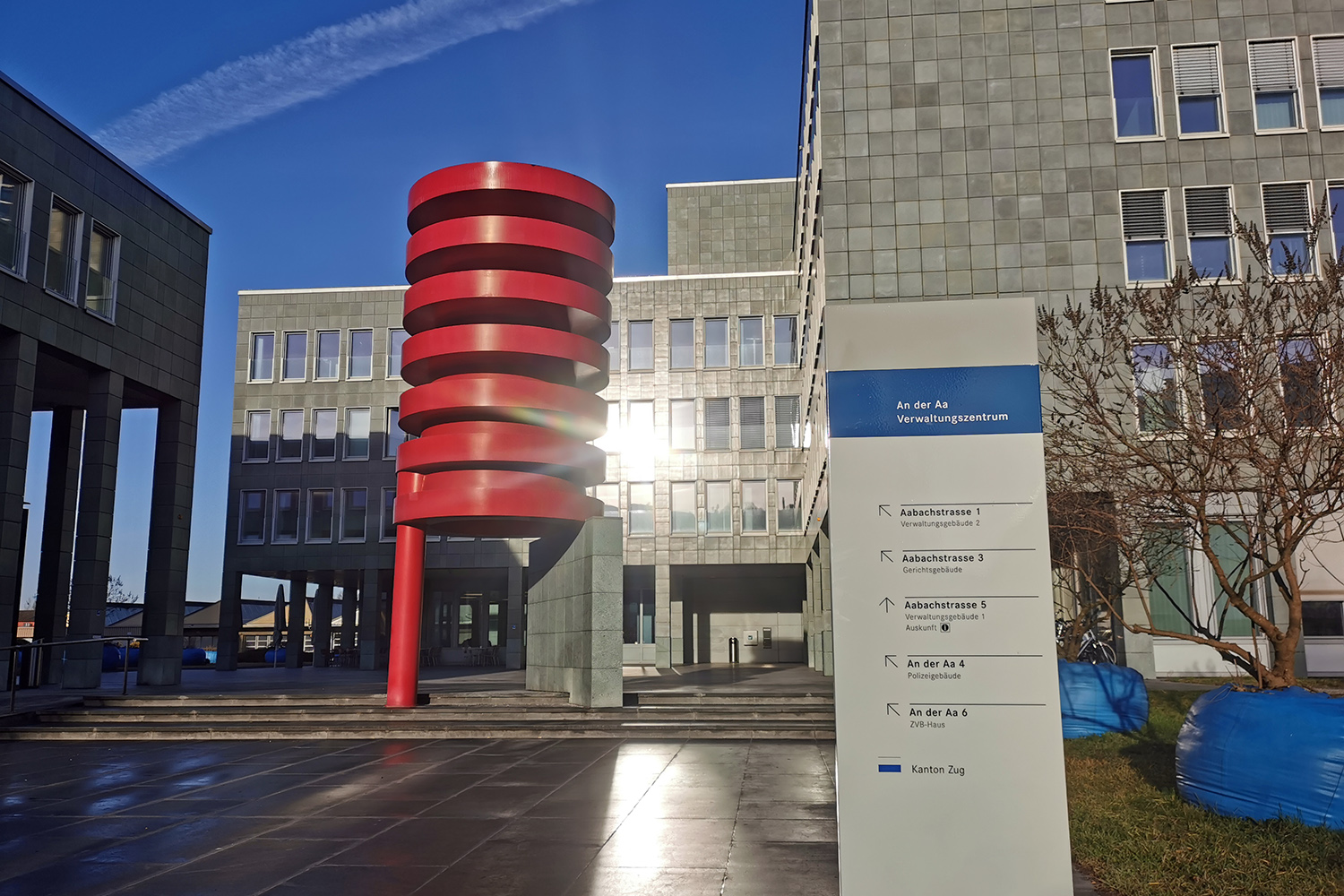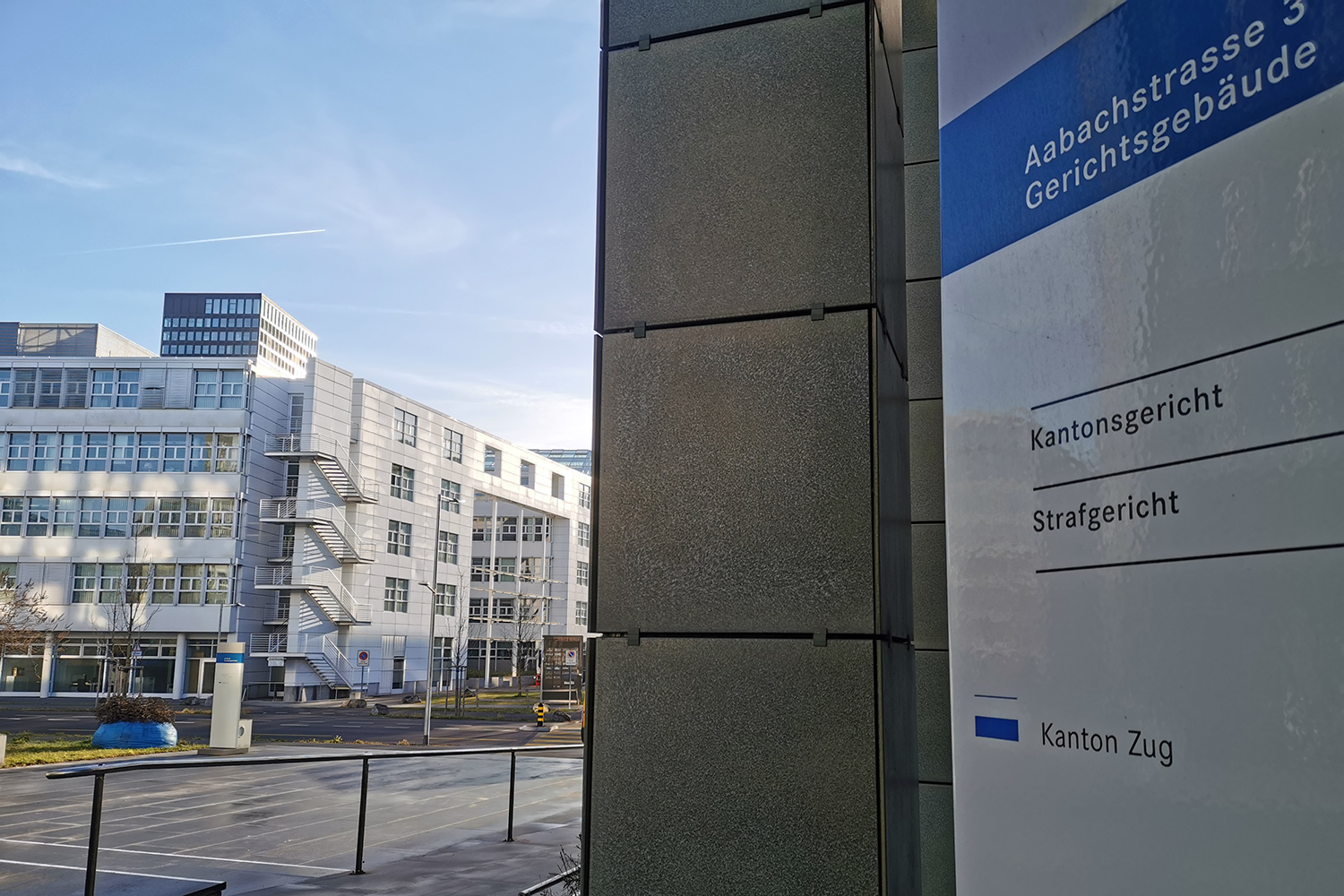
Limiting climate change by working for Switzerland’s biggest CO2 polluter

Magali Anderson wants to lead the way in solving the climate crisis. The engineer has chosen an unconventional place to do this: as a top manager with the cement producer Holcim, Switzerland’s largest emitter of CO2. Not everyone agrees her strategy is working.
The cantonal court in Zug, central Switzerland, is clearly visible from Holcim’s headquarters. The recently completed administrative building has a clear-cut, imposing facade.
It is here that judges are currently considering the cement company’s climate responsibilities after a civil suit filed last January by four residents of the Indonesian island of Pari.
If the court holds Holcim liable for past, ongoing and future CO2 emissions and corresponding damages, the precedent will shake long-held certainties for many multinational corporations headquartered in Switzerland.

The court has not communicated when it will make its final decision.
Claims against big polluters by any person who has suffered from the effects of climate change could follow, regardless of whether a company has ever operated in the country.
For Holcim, the consequence would be a serious challenge to its business model. Judges in The Hague orderedExternal link the oil and gas company Royal Dutch Shell to significantly curb future emissions in a similar case in 2021. Shell appealedExternal link the decision the following year.
Some 200 metres away from the court, at Holcim headquarters in another neat and white office complex, Magali Anderson, a member of the company’s executive committee, is set on “building progress for people and the planet,” according to the panels in the entry hall.
This is the claim Holcim has set for itself. Publicly the multinational company is portrayingExternal link itself as “the global leader in innovative and sustainable building solutions.” As Holcim’s top manager for sustainability and innovation, Anderson is the key player in turning this aspiration into reality.
The French engineer is a symbol of the industrial practices at the heart of climate change. Her professional journey encompasses the most CO2-intensive lines of business.
Anderson started her career on an oil rig in Nigeria. Gradually she rose through the ranks of the fossil-fuel industry, including with oilfield service company Schlumberger, before arriving at Holcim, one of the world’s “carbon majors” — companies that account for the lion’s share of global historic greenhouse gas emissions.
However, Anderson is no longer working to advance business interests alone, the 56-year-old states with a discreet French accent. “Not long before I turned 50, I had a kind of wake-up call,” she says in an interview with SWI swissinfo.ch, as a company communications officer sits close by.

Shifting aspirations
“When I graduated as a young engineer, my motivation was adventure and science. Then my vision changed. I wanted to give purpose to my life,” Anderson explains. At that point she was ready to move on from the oil and gas industry. While having “no regrets,” she says she found a new sense of consciousness.
Information about environmental impacts of fossil fuels played an important role in this shift, by Anderson’s own account.
In the face of the climate crisis, her definitions of achievement and success started to change.
The turning point came when she was offered a role in health and safety at Holcim in 2016. After decades “on the business front” in manufacturing, maintenance and supply-chain management in the oil industry, Anderson was excited to change roles.
“Waking up in the morning with the objective of saving some lives was a good call,” says Anderson. Part of her work included implementing initiatives to reduce the number of on-site and road accidents related to Holcim’s operations to lower the number of injuries and fatalitiesExternal link.
When asked why shifting from one polluting industry to another seemed like a good choice, Anderson argues that cement is indispensable for the energy transition. As an example, she cites the need for cement when building infrastructure such as hydropower dams or the bases of wind turbines. Thus, changing the way cement is produced has a major impact on the climate, Anderson argues. “More sustainable industries like wood are nowhere close to concrete in terms of their importance for global construction.” she says.
Three years after she joined Holcim, the CEO, Jan Jenisch, asked her to become the group’s first Chief Sustainability Officer. “My objective turned from saving some lives to saving humanity,” she notes with a smile. She now is in charge of Holcim’s global climate strategy.
How much executives knew about the climate impacts of their operations and when will be one of the questions judges in Zug will consider when determining liability.
In the case before them, the residents of Pari claimExternal link that Holcim, through its CO2 emissions, infringed on their individual rights as defined in the Swiss Civil CodeExternal link.
Anderson refuses to comment on the ongoing court case but agrees to discuss Holcim’s climate strategy in detail.
How sound is Holcim’s climate strategy?
At the heart of the claim is the assertion that Holcim is doing “too little too late”. There are two main points of criticism of the company’s climate strategy.
The first is that Holcim, in the short term, has committed to cutting relative emissions, rather than absolute ones.
Holcim’s target, set in November 2022External link, is to reduce direct emissions per tonne of cementitious materials by 25% by 2030. HEKS, the Swiss NGO that supports the Indonesian claimants, is demandingExternal link a reduction of absolute and relative emissions of “at least 43%” by the same year, sayingExternal link that this is the required reduction path stated by the Intergovernmental Panel on Climate Change (IPCC) to limit global warming to 1.5°C.
Anderson argues that calling for absolute emissions reductions per company will just mean other cement producers will rush to meet demand. In 2022, Holcim sold its operations in IndiaExternal link, which reduced its overall CO2 impact.
The planet will be better off the bigger the share of the cement market Holcim takes, she says, “because among our peers, today we are producing one of the cements that are lowest in CO2.”
The Transition Pathway Initiative, led by the London School of Economics and the Grantham Research Institute to track the progress made by companies transitioning to a low-carbon economy, concluded in 2022 that Holcim’s carbon intensity was below the sector average.
Anderson is adamant that Holcim’s target is in line with the 1.5°C scenario. “The International Energy Agency (IEA) derives a high-level roadmap per sector from that [IPCC] report. The Science Based Targets initiative, which Holcim adheres to, derives pathways and validates targets for individual companies.”
It is precisely this pathway that HEKS criticises. The Church-affiliated group wants Holcim to reduce short-term emissions faster, in favour of newcomers or “small polluters”: companies with lower historical emissions and less money.
Ultimately, it is a dispute about who gets to use up the remaining carbon budget for the IPCC’s 1.5°C scenario.
De-carbonisation vs. de-growth
The second point of criticism of Holcim’s strategy is that it relies heavily on technologies to capture, utilise and store carbon (CCUS) to achieve net-zero emissions by 2050. The idea behind the technology is to remove CO2 from the atmosphere after it was emitted. HEKS argues that these engineering solutions are presented as a magic wand but may not work out at the scale required.
“I am a great believer in CCUS because it is something that the world needs, not just for cement,” says Anderson. Citing figures from the IEA (almost 45 metric tonnes of CO2 captured globally in 2021External link) and major investments in the technology by governments (the European Union Innovation FundExternal link recently spent half a billionExternal linkEuroExternal links on CCUS projectsExternal link in the cement industry)she says CCUS is a proven concept backed by political willExternal link.
“What we are working on is to prove that CCUS works at scale,” Anderson adds. “But there is no alternative to making it work because the population is not expected to embrace de-growth.” De-growth refers to the shrinking of the economy.
This point goes back to the heart of Anderson’s motivation and logic: she sees no viable replacement for cement as a construction material.
Holcim cooperates with the construction industry to use less cement in building work, Anderson says. But she stresses that such change takes time. “So we have no choice,” she concludes. “We have to de-carbonise cement. There is no other way.”
Holcim developed a lower-carbon concrete called “ECOPact” that hit the market in July 2020. The product accounted for 13% of total net sales of the company’s concrete ready-mix in 2022.
At the Institute for Building Materials at the federal technology institute ETH Zurich, researchers Robert Flatt and Franco Zunino see a general trend in the cement industry to reduce CO2 driven by societal pressure, carbon taxes and regulation. “Holcim is certainly moving in the right direction, but they are not the only ones doing it,” says Zunino, a specialist in low-carbon concrete.
Working in one of the most polluting industries is Anderson’s way of taking climate action. Whether the change is happening fast enough and goes far enough will be up to the court next door to decide.
Edited by Virginie Mangin, gw

In compliance with the JTI standards
More: SWI swissinfo.ch certified by the Journalism Trust Initiative





























You can find an overview of ongoing debates with our journalists here . Please join us!
If you want to start a conversation about a topic raised in this article or want to report factual errors, email us at english@swissinfo.ch.